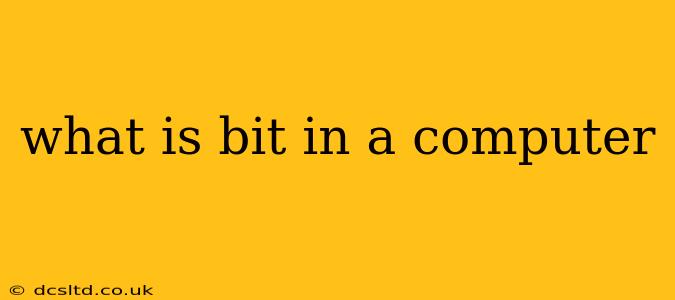The seemingly simple question, "What is a bit in a computer?", unveils a fundamental concept that underpins the entire digital world. At its core, a bit (short for binary digit) is the smallest unit of data in a computer. It represents the most basic form of information: a single binary value, either 0 or 1. Think of it as a tiny light switch—either on (1) or off (0). While seemingly insignificant on its own, the combination of billions of these bits creates the complex digital world we interact with daily.
How Bits Represent Information
Bits themselves don't directly represent letters, numbers, or images. Instead, they're grouped together to form larger units, like bytes (8 bits), kilobytes (1024 bytes), megabytes, gigabytes, and so on. These groupings allow for the encoding of all kinds of data.
For example, the letter "A" might be represented by a specific sequence of eight bits, such as 01000001. Similarly, numbers, colors, and even sounds are all encoded as unique sequences of bits. This intricate system of binary encoding allows computers to store and process virtually any type of information.
Understanding the Significance of Bits
The significance of bits goes far beyond their simple binary nature. Here's why understanding bits is crucial:
- Foundation of Digital Data: Every file, program, image, video, and piece of information stored or processed on a computer is fundamentally composed of bits.
- Data Processing: Computers perform calculations and logical operations by manipulating individual bits. For instance, adding two numbers involves manipulating the bit patterns representing those numbers.
- Data Storage: From hard drives to RAM, all computer storage mechanisms store information as sequences of bits.
- Data Transmission: When data is transferred over a network, it's transmitted as a stream of bits.
Frequently Asked Questions about Bits
Here are some frequently asked questions that delve deeper into the world of bits:
What is the difference between a bit and a byte?
A bit is a single binary digit (0 or 1), while a byte is a group of eight bits. Bytes are a more practical unit for measuring data because a single bit holds too little information to be useful on its own.
How are bits used to represent colors?
Colors are typically represented using a system like RGB (Red, Green, Blue). Each color component (Red, Green, and Blue) is assigned a certain number of bits, often 8 bits each. This allows for 256 different levels of intensity for each color, resulting in a wide range of color possibilities. For example, a 24-bit color image uses 8 bits for each of the red, green, and blue components.
How do bits relate to computer speed?
The speed at which a computer processes data is often measured in bits per second (bps) or multiples thereof (kilobits per second, megabits per second, etc.). A higher bit rate means more data can be processed or transmitted per second. This relates to the processing power of the CPU and the bandwidth of the network connection.
Can a bit have values other than 0 and 1?
No, a bit, by definition, can only have a value of 0 or 1. This binary system is the fundamental language of computers. While more complex data structures can be built upon bits, the individual bit itself remains binary.
In conclusion, understanding the bit is key to comprehending the inner workings of computers and the digital world. While seemingly simple, its fundamental role in representing and processing information cannot be overstated. From the smallest data unit to the most complex algorithms, the bit forms the very bedrock of the digital age.
